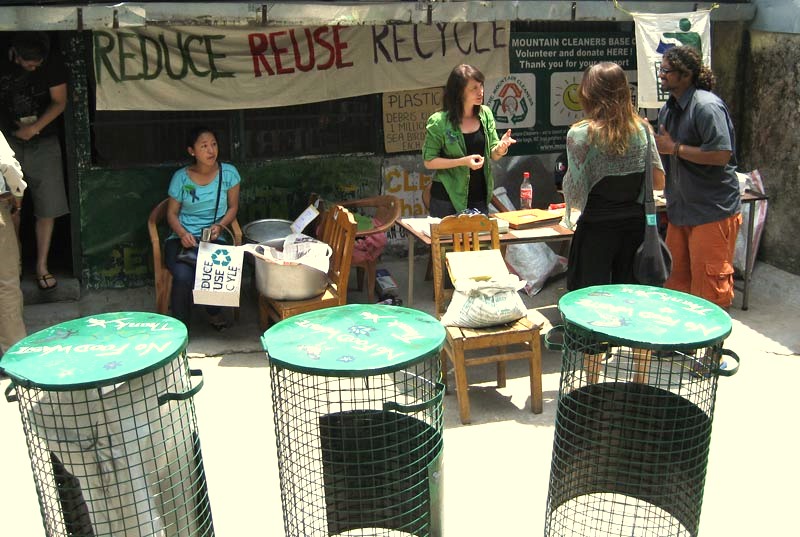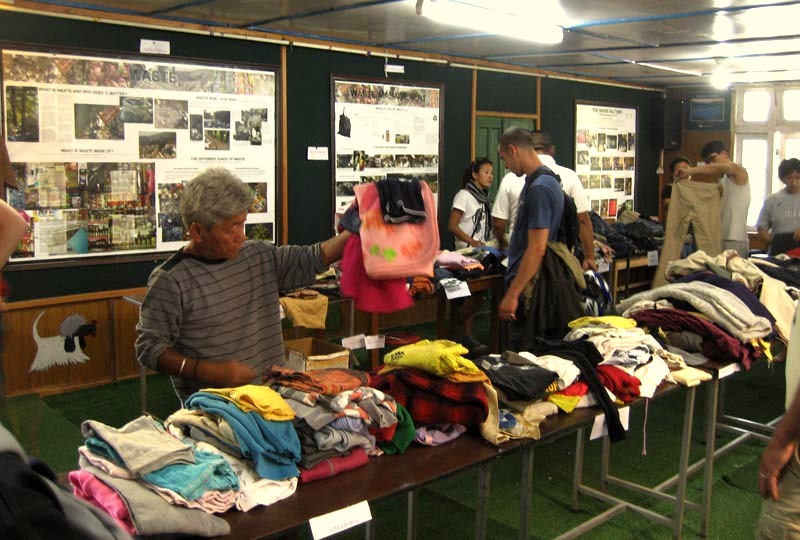 Dharamshala: - This is part one in a series of three articles called Cleaning Up Dharamshala - When Garbage Builds Bridges. In the spirit of World Environment Day on June 5th, The Tibet Post International explores the pioneering waste management projects taking place in His Holiness, the Dalai Lama's town of residence, McLeod Ganj. For a more detailed introduction, see Cleaning Up Dharamshala - When Garbage Builds Bridges.
Dharamshala: - This is part one in a series of three articles called Cleaning Up Dharamshala - When Garbage Builds Bridges. In the spirit of World Environment Day on June 5th, The Tibet Post International explores the pioneering waste management projects taking place in His Holiness, the Dalai Lama's town of residence, McLeod Ganj. For a more detailed introduction, see Cleaning Up Dharamshala - When Garbage Builds Bridges.
It is June 5th - World Environment Day - and the Tibetan initiative, Clean Upper Dharamshala Project (CUDP) headquarters is buzzing with activity. Volunteers from at least three continents are welcoming curious by-passers, drawn to the site by laid back music and the aroma of fried potato served on large plant-leaves, stitched together by toothpicks. I decide to try one out of curiosity for the natural container.
Himachal Pradesh, where Dharamshala is located, was in fact the first Indian state to pass an act on solid waste management and as a result, plastic bags are now banned. Recently another piece of legislation was passed, banning non-degradable, disposable plates, cups and cutlery. The new law only takes effect from August, but here at the CUDP they are already presenting an alternative.
Knowing the Basics
The CUDP generally works with two types of waste. One is non-recyclable, "wet waste" like used tissue, biscuit and candy wrappings, food waste and juice cartons. The other type is dry waste, which is recyclable items such as paper, metals, clear plastics, glass and fabric. Even shoe-soles are apparently recyclable.
One piece of advice, however, stands out to me from the many educational posters at the CUDP: "Never burn your waste". On every day of my stay in India, my nose has been pierced with the acrid smell of burning trash in the streets. Ending that practice seems an enormous task, but fortunately some people are not so easily discouraged.
The week before, I had met with the assistant environment coordinator of the project to find out how the Tibetan Central Administration ended up taking care of the garbage in this North-Indian town.
Early Responsibility
Tenzin Choedon, 27, has an air of friendly efficiency about her as she welcomes me in the CUDP's small, but busy office on a main road in McLeod Ganj. It is obvious that, although it is only her third year in the job, Choedon knows the operation inside out, and I am quickly deep into the history of the project.
"In the 1980's we didn't have much environmental problems here and 90% of the waste was bio-degradable", she begins; "but in the 1990's with more and more tourism and Tibetan refugees coming here, waste was becoming a big problem for the environment and to people's health".
Choedon's serious look gives way to a smile when she adds, "so that's when the Tibetan Settlement Office voluntarily took the responsibility to start this project on World Environment Day in 1994."
Working for the Community
"The back-bone of the waste management project is our Green Workers", says Choedon, "they go and collect all the recyclable waste from the households at 7.30 in the morning yelling "ghey nyi kampo", which means dry waste in Tibetan".
The Green Workers also operate the trucks for the wet and dry waste. Driving around the areas, they blow the horn at certain stops. After the rounds, for those driving the wet waste truck, the stinking task of further segregation in the back of the truck awaits. "Dharamshala is a very mobile community. People come and go here, and we cannot be sure that everybody is segregating" Choedon explains.
The generous mix of nationalities that inhabits McLeod Ganj and surrounding area is duly reflected in the staff at the CUDP, which consists of both Indians and Tibetans plus a handful of international volunteers. From the lunch-room next door I can hear a happy banter slipping easily from one language into another. Choedon continues, "with both the wet and dry waste taken care of, what we are left with is the street garbage".
The CUDP has a separate Sweeper Team of 15 Indians who clean the market streets of the area every morning and fix the blocked drains in the afternoon. Their salaries more or less make out the Rs. 50.000 which the Dharamshala Municipal Council pays the CUDP every month, leaving little money for truck-maintenance, petrol etc..
In 2002 the CUDP became legally responsible for the area's garbage management through a contract with the council. But Choedon tells me that the project is still running with a loss and that, in about a year and a half, the savings from their start-up grants will come to an end unless further funding is secured.
Just then three Tibetan women arrive at the office to pay the yearly contribution for their "environment card". Only Tibetans have the card which entitles them to make use of the CUDP's services. Although Indian residents also has their waste picked up by the CUDP, their environment fees go to the municipal council who, in turn, pays the CUDP a monthly rate.
While the women get their payments registered, I wonder how the locals respond to the CUDP's work. "Even within my three years here I see more and more people really getting interested in the environment", Choedon answers. "Even if they come to complain I can at least see that they actually care!"
Spreading the Word
The CUDP also houses a community hall where local assembly meetings and other functions are held. The hall simultaneously serves as an environment eductaion center with information displays on the walls. An essential part of the CUDP's work is to educate the public.
A public talk is planned for later this month, but Choedon doesn't seem convinced that people will listen much to her advice: "We are focusing more on the school kids, if we teach them really good, they will go back home and tell their parents when they are doing the wrong thing. Parents like that, it touches their hearts."
The CUDP was the first waste management project in a Tibetan settlement and it has since become a role model. In 2004, Tibetans from all over India were given workshops here, and now the five biggest settlements in South India have implemented a waste management project.
A Critical End
Despite the obvious problems of funding and limited jurisdiction, the CUDP seems almost too successfull to be true for a journalist. Looking for a weak point I ask about the one place where nothing more can be done to prevent pollution; the dumping site.
"It is not a proper land-fill" Choedon answers. "Like most places in India, it is just a barren piece of land where you start throwing the waste and then it becomes a dump site!" she says and shakes her head.
"This is why we started the composting projects. We were really worried about the amount of waste that was going to the dump site." Having started with bigger institution's mass kitchens, more composts are slowly being established. "Soon we will have concrete examples for many people to learn from", she tells me confidently.
But my mind is still occupied with the dump site. Only those who work there ever see the accumulated ugliness of our combined consumption. As I leave the office I ask if it is possible to see the site and to my big surprise Choedon offers, "why don't you go there with Jigmey and Preetam on the dry waste truck tomorrow?"
In a matter of minutes arrangements are made and I am promised a lift with the waste truck to the end of the line. Looks like I will have to do some dirty research...
Join the TPI again next week for a multi-religious truck-ride to the Dharamshala dumping site where the non-degradable products of everyday living find their final destination. Not to mention a cross-cultural interview with the hard-working Mountain Cleaners, who have turned trekking into hands-on environmental activism. Also, a possible answer might come to the big question: "Where are the bins?"


![Tibet has a rich history as a sovereign nation until the 1950s when it was invaded by China. [Photo: File]](/images/stories/Pics-2024/March/Tibet-Nation-1940s.jpg#joomlaImage://local-images/stories/Pics-2024/March/Tibet-Nation-1940s.jpg?width=1489&height=878)
















